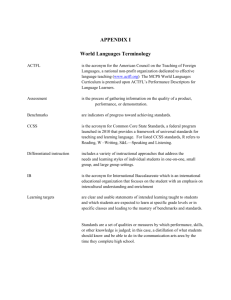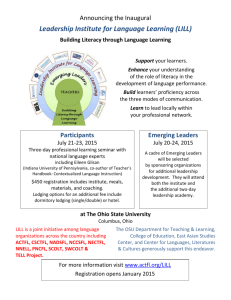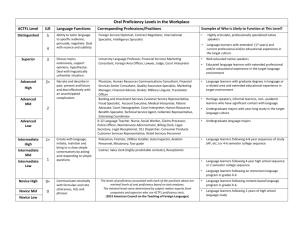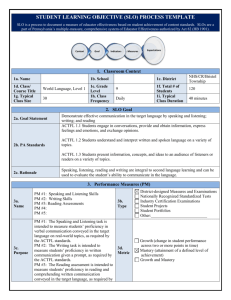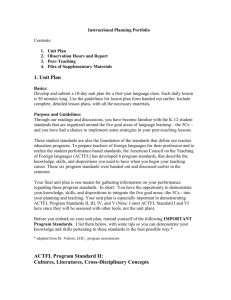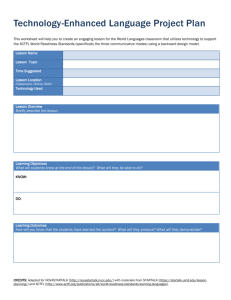The Common Core Framework and World Languages
advertisement
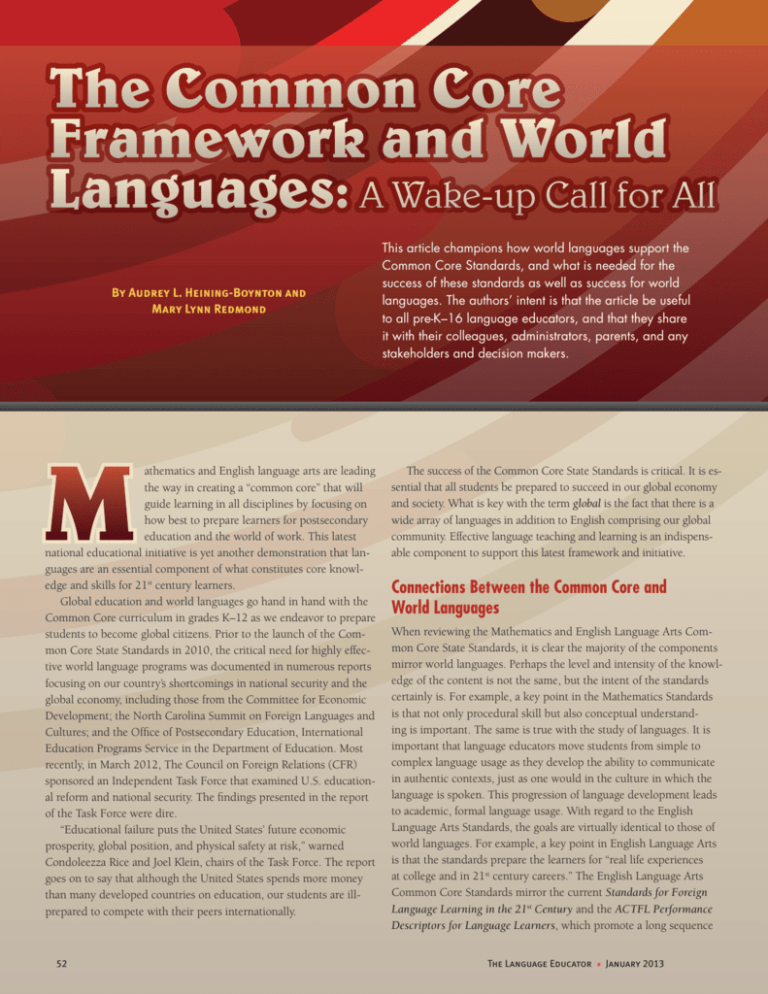
By Audrey L. Heining-Boynton and Mary Lynn Redmond athematics and English language arts are leading the way in creating a “common core” that will guide learning in all disciplines by focusing on how best to prepare learners for postsecondary education and the world of work. This latest national educational initiative is yet another demonstration that languages are an essential component of what constitutes core knowledge and skills for 21st century learners. Global education and world languages go hand in hand with the Common Core curriculum in grades K–12 as we endeavor to prepare students to become global citizens. Prior to the launch of the Common Core State Standards in 2010, the critical need for highly effective world language programs was documented in numerous reports focusing on our country’s shortcomings in national security and the global economy, including those from the Committee for Economic Development; the North Carolina Summit on Foreign Languages and Cultures; and the Office of Postsecondary Education, International Education Programs Service in the Department of Education. Most recently, in March 2012, The Council on Foreign Relations (CFR) sponsored an Independent Task Force that examined U.S. educational reform and national security. The findings presented in the report of the Task Force were dire. “Educational failure puts the United States’ future economic prosperity, global position, and physical safety at risk,” warned Condoleezza Rice and Joel Klein, chairs of the Task Force. The report goes on to say that although the United States spends more money than many developed countries on education, our students are illprepared to compete with their peers internationally. 52 This article champions how world languages support the Common Core Standards, and what is needed for the success of these standards as well as success for world languages. The authors’ intent is that the article be useful to all pre-K–16 language educators, and that they share it with their colleagues, administrators, parents, and any stakeholders and decision makers. The success of the Common Core State Standards is critical. It is essential that all students be prepared to succeed in our global economy and society. What is key with the term global is the fact that there is a wide array of languages in addition to English comprising our global community. Effective language teaching and learning is an indispensable component to support this latest framework and initiative. Connections Between the Common Core and World Languages When reviewing the Mathematics and English Language Arts Common Core State Standards, it is clear the majority of the components mirror world languages. Perhaps the level and intensity of the knowledge of the content is not the same, but the intent of the standards certainly is. For example, a key point in the Mathematics Standards is that not only procedural skill but also conceptual understanding is important. The same is true with the study of languages. It is important that language educators move students from simple to complex language usage as they develop the ability to communicate in authentic contexts, just as one would in the culture in which the language is spoken. This progression of language development leads to academic, formal language usage. With regard to the English Language Arts Standards, the goals are virtually identical to those of world languages. For example, a key point in English Language Arts is that the standards prepare the learners for “real life experiences at college and in 21st century careers.” The English Language Arts Common Core Standards mirror the current Standards for Foreign Language Learning in the 21st Century and the ACTFL Performance Descriptors for Language Learners, which promote a long sequence The Language Educator n January 2013 Effective language teaching and learning is an indispensable component to support this latest framework and initiative. of language study in grades K–12 so that students have the opportunity to gain a high level of communication ability in a world language in addition to English. A good demonstration of how world languages connect with the Common Core State Standards is a 2012 document developed by ACTFL entitled, “Alignment of the National Standards for Learning Languages with the Common Core State Standards.” This directly aligns the English Language Arts Common Core State Standards with the National Standards’ three modes of communication (interpersonal, interpretive, presentational) as well as the ACTFL Proficiency Guideline Levels of Novice, Intermediate, and Advanced. Connecting the Common Core Standards to Language Study In order for all students to be prepared to succeed in our 21st century global economy and society, all students must be proficient in multiple languages. Formal English is essential for college and 21st century career success, and the ability to communicate in languages in addition to English is equally important. Emerging nations and economies in Latin America, Asia, and the Middle East make it clear that while English is an important language, it is not the only world language. When considering this need for multilingual global citizens, our English language learners possess the potential for an edge in positioning themselves as leading world citizens. They come to our schools with at least one home language; they are then entrusted in our care to add English to their repertoire. It has been suggested on many occasions in the past that these students possess a “value added” by being multilingual. If English language learners possess value-added qualities, what does that say about our U.S. students who speak and are studying only English? National statistics report that approximately 8 out of 10 Americans speak only English, and a decreasing number of schools are offering world languages in their curricula. It is clear that learners without strong language instruction in addition to English will be at a severe disadvantage in terms of being prepared for our global economy and society. communicate using formal, academic English, and their heritage language is also not at a satisfactory proficiency level. They simply have not been well-prepared for college and the workforce. Finding Solutions: The Lowest Common Denominators for Program Success There are indeed schools that have been successful in world language instruction over the past decades, with success being defined as high levels of student performance and competence in all world languages including English. Those schools and programs have been successful with other national initiatives (e.g., No Child Left Behind, 21st Century Skills Maps, etc.), and will continue to excel with the Common Core State Standards in place, or any other future initiative. What all of these schools have in common are what we can refer to as the lowest common denominators for success in achieving high levels of world language competence. These lowest common denominators are: Administrators who support a rigorous curriculum of languages in addition to English The State of Language Instruction and What We Need to Do There are some who say that our U.S. schools have been teaching world languages for decades with poor results in language acquisition; that is a fair criticism. Decade after decade our pre-K–12 students have enrolled in and studied multiple years of a language in addition to English. They then enter college, only to be placed in beginning language courses. The same can be said for high school graduates who directly enter the world of work. Even after multiple years of study, they too are unable to communicate in the most basic of ways with those who do not speak English. Sadly, there are English language learners/heritage language learners who are in a double jeopardy situation. They are unable to The Language Educator n January 2013 A strong leader must be at the helm of a school to set the course for high expectations in language learning. Strong leaders keep language learning focused on the deliverable of students able to use language in meaningful ways at high levels of proficiency. This goal must lead to curriculum, instruction, and assessment aligned with high levels of proficiency in whatever languages are being taught. Without the support of school administrators, language programs face more challenges to sustain themselves successfully. The programs become expendable during difficult economic times. 53 The Common Core Framework and World Languages Well-trained language teachers who maintain high standards for all The Council on Foreign Relations called in 2012 for the United States to “implement educational expectations and assessments in subjects vital to protecting national security.” Manageable class sizes in well-maintained schools Talented, well-trained teachers who are able to engage all learners in meaningful instruction with rigorous expectations are essential for student success. These educators are able to consistently incorporate in their instructional delivery higher-order skills supported by germane research findings that promote learning, such as a constructivist approach. These outstanding teachers create studentcentered classrooms where they immerse their learners in languagerich experiences and motivate them to succeed. Their objectives are measurable and appropriate, and they employ best practices that are performance-based, moving the student forward toward increased language proficiency. Language teachers must create a rigorous, evidence-based curriculum that incorporates higher order thinking and literacy, as detailed in the Common Core State Standards. Teaching and assessing with the standards as a guiding principle is essential. Moving in step with the Common Core State Standards is key for all disciplines. Professionals of world languages including English must be among the leaders of the initiative. Teachers and learners can be most successful when class sizes are manageable in well-maintained schools. All students deserve the opportunity to learn in a setting where their needs can be met and they can thrive. In a position statement on maximum class size released by ACTFL in 2010 that supported similar statements from the National Education Association and the Association of Departments of Foreign Languages, it was stated that class sizes should not exceed 15 students. All of our pre-K–12 student populations merit the attention and stimulation of creativity that smaller class sizes in supportive settings afford. What is interesting to note about the preceding three lowest common denominators for success is that they are the three basic components for any content area’s success. Reflecting on the close ties between the Common Core State Standards and world language education, The CFR’s Independent Task Force in 2012 proposed three overarching policy recommendations; the first most directly related to world language instruction and the Common Core State Standards. The call was to “implement educational expectations and assessments in subjects vital to protecting national security.” The recommendations went on to say that states should expand the Common Core State Standards. The CFR further stated that “the lack of preparedness poses threats on five national security fronts: economic growth and competitiveness, physical safety, intellectual property, U.S. global awareness, and U.S. unity and cohesion.” Continued on p. 56 54 The Language Educator n January 2013 The Common Core Framework and World Languages T he message is clear: The standards for teaching and learning language are well-aligned with the Common Core State Standards for English Language Arts and Literacy in History/Social Studies, Science, and Technical Subjects. Recently, ACTFL convened an expert group of local and state supervisors for languages to create a crosswalk of how the National Standards for Language Learning connect with the Common Core Standards. Educators are looking at how best to support the four strands of Common Core for English Language Arts (ELA) and Literacy (Reading, Writing, Speaking and Listening, and Language) through the language standards’ three modes of communication (interpersonal, interpretive, and presentational) and the proficiency levels (novice, intermediate, advanced). See: www. actfl.org/commoncore. Making the connection conceptually is the easy part; more challenging is identifying exactly what this looks like across levels. The crosswalk document showcases examples of how learners improve their literacy skills as they increase their language performance from novice to intermediate to advanced levels. Here is an example from the writing strand, linking language learning with the Common Core standards on how to conduct research to build and present knowledge: Novice Students Intermediate Students Explain a local or global practice, product, or issue. Utilize one or two credible sources, skimming and scanning websites, to create surveys or complete graphic organizers. Explore local and global issues to prepare summaries, or short reports utilizing digital tools. Utilize a few sources and occasionally reference these sources accurately. Evaluate credibility and accuracy of the source. Advanced Students Summarize texts intended for native speakers to support analysis, reflection and research related to global issues while integrating crosscultural perspectives. Utilize a variety of sources and reference these sources accurately, including international and domestic sources in the target language (e.g., heritage/immigrant community newspapers, radio and TV broadcasts, or websites). The new ACTFL Performance Descriptors for Language Learners (highlighted on p. 29 of this issue) describe how language learners move from the novice range of performance to the intermediate range, and from the intermediate range to the advanced range. The Performance Descriptors provide details of the parameters for language performance in instructional settings and of how and how well language learners will understand and be understood. The Performance Descriptors help educators plan instruction and assessment and help learners identify what they need to know and be able to do to improve their language performance. See: www.actfl.org/publications/guidelines-and-manuals/ actfl-performance-descriptors-language-learners. The Language Educator n January 2013 55 The Common Core Framework and World Languages Continued from p. 54 Resources on the ACTFL Website For world language instruction, this is a wake-up call. The language education community must step up to the plate, primed to do its part to prepare productive global citizens. This includes school administrators supporting high-quality language programs. It also includes language educators’ instructional delivery always keeping the target in sight, which is preparing all students to succeed linguistically and culturally in our global economy and society. Moving in step with the Common Core State Standards is key for all disciplines. Professionals teaching world languages including English must be among the leaders of the initiative. ACTFL Performance Descriptors for Language Learners — NEW www.actfl.org/publications/guidelines-and-manuals/actflperformance-descriptors-language-learners Audrey L. Heining-Boynton is a Clinical Professor of Foreign/Second Language Education at the University of North Carolina at Chapel Hill School of Education, Chapel Hill, NC. She served as ACTFL President in 2005. Mary Lynn Redmond is a Professor of Education at Wake Forest University, WinstonSalem, NC. She served on the ACTFL Board of Directors, 2010–2012, and was recently elected as ACTFL President for 2014. Read more about this new document on p. 29 of this issue ACTFL Position Statement on Maximum Class Size www.actfl.org/news/position-statements/maximum-class-size Alignment of the National Standards for Learning Languages with the Common Core State Standards www.actfl.org/sites/default/files/pdfs/Aligning_CCSS_ Language_Standards_v6.pdf A View from the Top: A Report from the North Carolina Summit on Foreign Languages and Cultures, Wake Forest University www.actfl.org/sites/default/files/NCSummit-FLandCultures.pdf Standards for Foreign Language Learning in the 21st Century www.actfl.org/publications/all/national-standards-foreignlanguage-education World Languages ACTFL P21 Skills Map www.actfl.org/sites/default/files/pdfs/21stCenturySkillsMap/ p21_worldlanguagesmap.pdf Additional References in this Article Common Core State Standards Initiative www.corestandards.org/ Education for Global Leadership: The Importance of International Studies and Foreign Language Education for U.S. Economic and National Security, Committee for Economic Development www.ced.org/images/library/reports/education/report_ foreignlanguages.pdf Gottlieb, K., de Sam, M., Dougan, B., Gordon, J., Puaschunder, J., & St. Clair, C. (2008). Building a globally competent citizenry in the United States. U.S. Department of Education, Office of Postsecondary Education, International Education Programs Service. Revised ACTFL Proficiency Guidelines actflproficiencyguidelines2012.org/ U.S. Education Reform and National Security, Council on Foreign Relations www.cfr.org/united-states/us-education-reform-nationalsecurity/p27618 56 The Language Educator n January 2013
